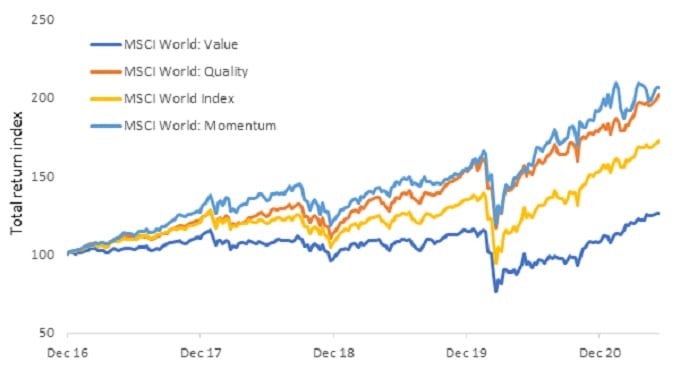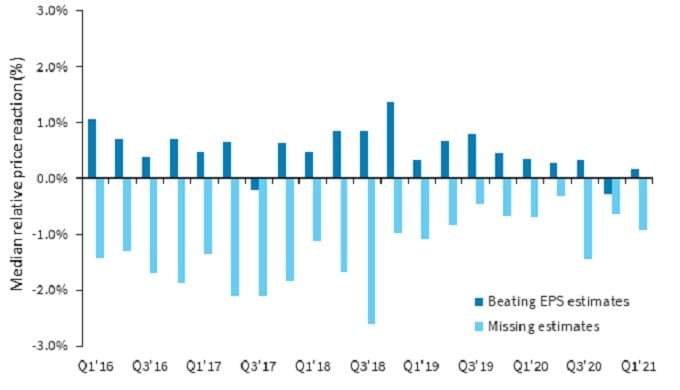Subscribe
Sign up for timely perspectives delivered to your inbox.

There is no denying that the factor-driven environment has been a significant contributor to the pattern of returns across the market over the past few years. The trade-off between value and growth has dominated the market narrative. Growth has consistently outperformed value since 2016, interspersed with a few ‘straw fires’ for value that quickly ran out of fuel. 2020 saw the beginnings of what could represent a more significant shift. While the onset of the pandemic in early 2020 hit across market styles – growth, momentum, quality and value among others – value was once again left behind in the subsequent bounce, as investors moved quickly to de-risk their portfolios (exhibit 1).

While growth has long been the dominant factor, we saw a turning point in early November 2020, with Pfizer/BioNTech the first to announce a breakthrough on what looked like an efficient vaccine for COVID-19, swiftly followed by Moderna and Oxford/AstraZeneca. This breakthrough in the fight against the virus marked the start of a broader market rotation that has favoured value/momentum at the expense of more growth-oriented stocks.
This rotation has not been without setbacks. Stalling bond yields favoured more defensively positioned stocks in March and April 2021, but if bond yields resume their upward trend, as we expect, the value style and more economically sensitive ‘cyclicals’ are likely to remain in favour. We are also conscious of the strong tailwinds for businesses as economies continue to reopen, especially in Europe, where there is plenty of room to catch up with the US. That said, if bond yields rise too fast and too high, equities more generally could be set for a period of consolidation – markets are walking a tightrope in this late-cycle period.
Outside this, earnings season for the first quarter of 2021 was noteworthy. Since the start of the pandemic, companies that managed to beat earnings per share (EPS) expectations have been sparsely rewarded, while those companies that have fallen short have been punished. The overall median share price reaction to results has been negative in the US (exhibit 2) and even more so in Europe (exhibit 3), indicative of lofty valuations and elevated expectations.


Although the stock-picking environment has been fraught with challenges, particularly on the short side, the rise in idiosyncratic (stock-specific) risk in early 2021 (exhibit 4) poses interesting questions. While factor contribution[1] remains higher than stock-specific[2] contribution, a potentially improving environment for stock pickers could be beneficial in future earnings seasons, if positive (or negative) corporate fundamentals feed through to results.

While stock-specific contribution is rising, we cannot ignore that factor contribution remains relatively significant. Not only have the markets been more heavily dominated by factor risk, we have found that thematic buckets (‘COVID winners’ being one such example) have played a key role in determining market movements. Risk models can be very good at analysing volatility and correlation, but it is a more challenging issue to account for thematic risk. This places a greater emphasis on portfolio construction to minimise bias to specific factors identified as a potential risk and help manage any consequent impact on performance.
We are conscious that the macroeconomic cycle may peak later in 2021, which could well coincide with a sharp rotation away from more cyclical areas that have done well in recent months, towards defensive sectors that have been the main underperformers. Inflation and the pace of rising bond yields will likely be a key determinant in the timing of this. We expect to see the last leg of the macro acceleration, boosted by a broader reopening in the US and across European economies, alongside sizeable fiscal stimulus, over the coming months. We are closely watching purchasing managers’ indices (PMIs), which historically serve as a good leading indicator. In the event that a peak in PMIs is followed by a market correction, those market neutral strategies combining bottom-up stock picking with a risk-aware quantitative approach to portfolio construction may be in a position to capitalise.
[1] Factor risk/contribution: here used to describe broader macroeconomic or geopolitical trends and investor behaviours affecting the market, such as COVID.
[2] Specific factor risk: issues that apply to a specific company, industry or sector.